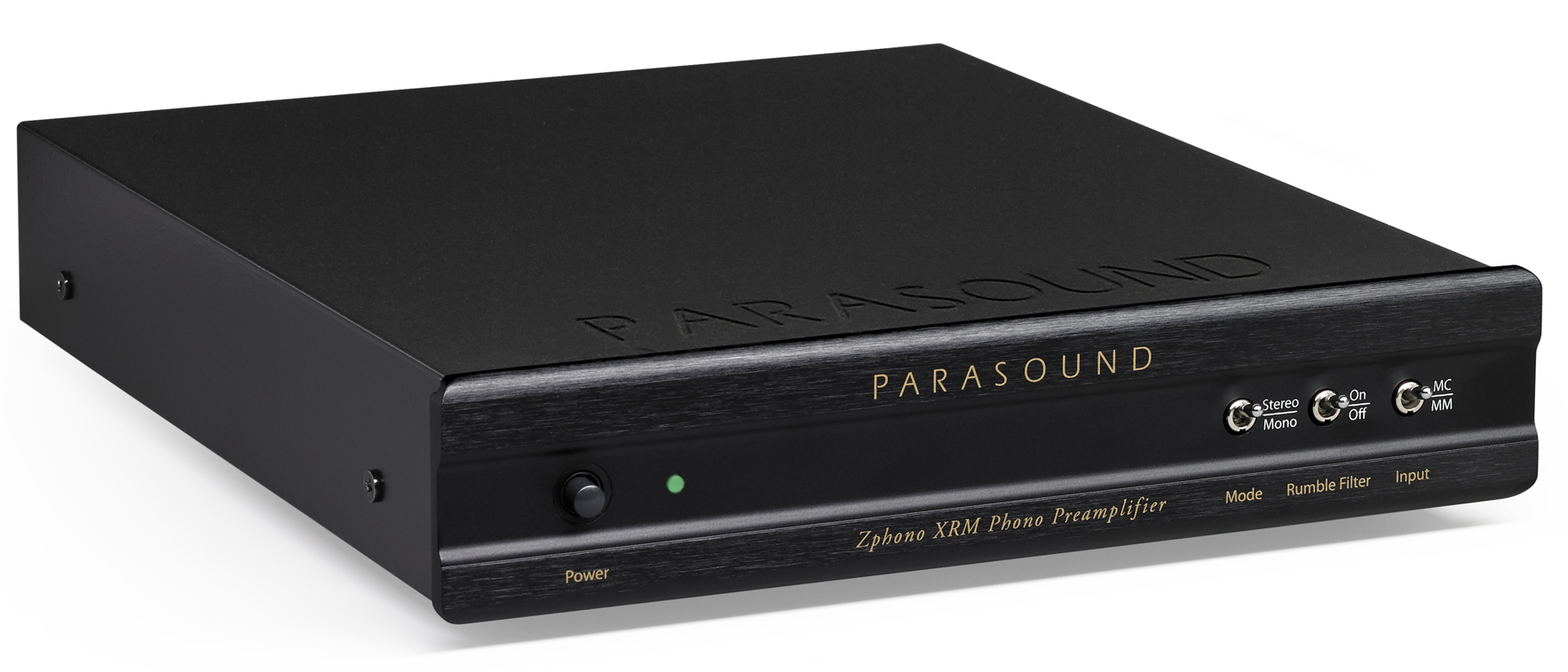What Hi-Fi? Verdict
Despite a cramped rear panel and relatively plain design, the Zphono XRM packs in all the high-end performance, power and functionality you could ever want from a phono preamp.
Pros
- +
Continously variable load impedance
- +
Rumble (high-pass) filter
- +
Balanced outputs
Cons
- -
RCA terminals too close together
- -
No standby mode
- -
No-frills chassis
Why you can trust What Hi-Fi?

This review and test originally appeared in Australian Hi-Fi magazine, one of What Hi-Fi?’s sister titles from Down Under. Click here for more information about Australian Hi-Fi, including links to buy individual digital editions and details on how to subscribe.
Given that famous amplifier designer John Curl does so much work for Parasound, we mistakenly assumed he must have been responsible for the company’s latest phono preamplifier, the Zphono XRM. We were wrong.
The new Zphono XRM phono preamp is a co-design that involved Parasound’s owner and founder, Richard Schram, and two other engineers he’s worked with for some years.
John Curl did have some involvement however, because Schram told us during our fact-checking process that “While John Curl didn’t design the XRM, he did offer me some useful suggestions that take it up a notch from ordinary phono stages.’”
As for the reason for adding yet another phono preamplifier to the Parasound product portfolio, Schram says it was the result of a thought exercise. “I was thinking what would a vinyl lover without a large budget appreciate and perhaps salivate over?” he said.
He wanted the XRM to offer versatility and convenience and thought that the design should be informed by viewing it through the eyes of a vinyl enthusiast rather than an engineer. “This exercise led to the design heading off in some directions I hadn’t considered,” he said.
“One such being the inclusion of completely independent preamps for MM and MC cartridges… an approach that enabled us to optimise sound quality specifically for each input individually, rather than having to make a compromise to satisfy to competing requirements within a single preamp. Obviously, this approach also meant we could accommodate two turntables or a turntable with two tonearms.”
It’s likely that another reason for the introduction of the Zphono XRM was to plug the yawning gap in the Parasound’s product line-up between its entry-level Zphono phono preamplifier and its award-winning Halo JC 3 Jr phono preamp.
The latest hi-fi, home cinema and tech news, reviews, buying advice and deals, direct to your inbox.
Equipment
Parasound’s Zphono XRM is physically quite small, at 260mm deep, 218mm wide and 50mm high, yet it has a power supply built in, rather than being powered externally. The built-in power supply is pretty good, too, with a shielded power transformer, a high-quality bridge diode and filter capacitors.
But its small size means there’s not a lot of real-estate available to fit connectors, so the rear panel is pretty busy. But we’ll get to that in a moment. Let’s look first at the front panel.

As you can see from the photograph of it, the Zphono XRM has a push-button power switch with a green LED alongside it at the left of the front panel. At the right are three miniature toggle switches which are for (from left to right) mono/stereo switching, rumble filter switching, and input selection (MM or MC).
Mono/stereo switching is something that’s often left off phono preamplifiers, but is absolutely essential if you play mono LPs – though in this case we’d also recommend you use a mono phono cartridge. However the switch can be used when you play stereo LPs because although the sound will end up mono, it can help reduce surface noise and, weirdly enough, eliminate the weird ‘phasing’ effects that can sometimes occur when you’re playing well-worn LPs.
As for that rumble filter, it’s probably mis-named, because in 2020, We’d sincerely hope that no self-respecting audiophile would be using a turntable that produced any audible ‘rumble’. We personally would have labelled it a ‘high-pass’ filter and suggested that it might be useful if your home is close to a busy road or highway – or railway line – in which case low-frequency vibrations might be causing your stylus to generate sub-audible signals that could adversely affect sound quality.
Then there’s the fact that many LPs contain sub-audible – or in the case of many London Decca LPs, audible! – frequencies that should be removed because they weren’t ever supposed to be there in the first place.
Going around to that busy back panel, we find completely separate moving-coil (MC) and moving-magnet inputs, both with gold-plated RCA input sockets. The gain of the moving-coil input can be switched between 50 and 60dB, and that of the moving-magnet input between 40 and 50dB, both via miniature toggle switches.
Thanks to the use of a rotary potentiometer, the impedance of the moving-coil input is continuously variable between 50Ω and 1050Ω with each 100Ω increment identified by labels, and each 20Ω increment by a small line.
Why a rotary control rather than DIP switches, as many other phono amplifier manufacturers do? It’s a question we put to Schram, who told us: “phono stages designed by engineers without consideration of real-world end users often use DIP switches on the bottom or inside the chassis because it’s easier and cheaper. DIP switches aren’t always desirable for passing audio signals and these locations make it a real nuisance for users. I think one should be able to make adjustments “on the fly” without turning off the phono preamp. Life is already hard enough, so why make it harder with inconvenient switches, right?’
With all due respect to Schram, we can’t quite see what’s so hard about extracting four screws, removing a lid, setting a DIP switch (or two) and then replacing both lid and screws, because for most audiophiles, this would be a one-time only process, so once it was done, it would stay done and never need to be done again.
We guess Schram’s approach has merit if you’re one of those audiophiles who constantly swaps phono cartridges in and out, but even if you are, it’s still only around 5 minutes out of your life each time you swap, which is hardly the end of the world.
The Zphono XRM provides both unbalanced (via gold-plated RCA sockets) and balanced (via gold-plated XLRs) outputs. We would recommend you use the balanced outputs if possible, but if you have to use the unbalanced outputs, be warned that the MM input’s RCA terminals are so close to the RCA output terminals that there may not be room for them to co-exist if the plugs on the RCA leads are unusually bulky.

Listening
As it happens, we regularly use two completely different turntables. The ‘best’ turntable is fitted with an Ortofon Cadenza Blue moving-coil cartridge (which does not have a removable stylus) while the ‘second-best’ is fitted with a middling-quality Audio-Technica moving-magnet cartridge (which does).
This is only a fairly recent set-up which came about when we discovered the huge number of great LPs that is available for sale at garage sales. Hunting these down has now become a major Saturday pastime.
The problem with garage-sale LP ‘bargains’ is that they aren’t always bargains because we don’t get to hear them before buying them, and many are damaged. So, after first cleaning each LP after purchase, it gets its first playing on our second-best turntable, so that if it’s too scratched, or the groove too worn, it’s only a fairly low-cost, easily replaceable stylus that is bearing the brunt of the damage.
If the LP turns out to be playable, it then goes straight to our best turntable so we can transfer the sound to digital for a final clean-up as well as for permanent storage and casual replay.
You’d think that setting the load impedance for the Ortofon would have been easy, because all we’d have to do would be to dial in the load recommended by Ortofon. Not so fast!
Rather frustratingly, Ortofon’s load impedance recommendation is disappointingly wide, at ‘50-200Ω’. We suspect that Ortofon is being deliberately vague so that audiophiles whose phono preamps have either a fixed load impedance – or only a limited range of load impedances to apply – will have at least one setting that falls within this range.
If Ortofon had been specific and recommended a load impedance of, say, 63Ω, anyone whose phono pre-amp did not offer this exact value might seriously consider not buying the cartridge. If Ortofon had specified a value of 63Ω, this would not have been a problem if you owned a Zphono XRM, because you could have dialled in this exact value using the rear panel load impedance selector!
Since the Zphono XRM allowed us to select any impedance across the range recommended by Ortofon (or any impedance up to 1050Ω if we so chose), what setting would be best?
A primary consideration with any low-output moving-coil cartridge is to maximise its output voltage. To do this, the load impedance must be 10 times the cartridge’s internal d.c. resistance.
In the case of the Ortofon Cadenza, its internal d.c. resistance is 5Ω. (By the way, DO NOT attempt to measure the d.c. resistance of any phono cartridge with any type of multimeter… you will destroy the cartridge.)
This means that the minimum load impedance for the Cadenza has to be 50Ω. No problems, the Parasound Zphono XRM can provide this. But will this load result in the best sound quality? Probably not.
Best sound quality is usually achieved with twice the minimum load impedance, which in this case would be 100Ω. But one problem with this setting is that it assumes there is zero radio-frequency interference, which is rarely the case if you live in a city.
Increasing load impedance tends to decrease the level of r.f. interference, which means that depending on your physical location, increasing the impedance even further may result in an improvement in sound quality.
The good news is that you can do all this with the Parasound Zphono XRM.
Just in case you own an Ortofon Cadenza Blue and you’re looking for a load recommendation, we thought ours sounded best with the Zphono XRM’s input impedance knob set to just a tad over 150Ω. (Remember, however, that your tonearm/turntable leads will also affect the so-called ‘best’ setting of this control.)
As luck would have it, we also had problems choosing which gain setting we should use – 50dB or 60dB – because the Ortofon Cadenza Blue’s output (which the specifications say is 0.5mV at 1kHz at a recorded velocity of 5 cm/sec) is right on the cusp of choices… at least it is according to Parasound, which recommends that you use the 60dB setting ‘for low output moving coil cartridges whose output is less than 0.5mV’ and the 50dB setting ‘for high output moving coil cartridges.’
We ended up mostly using the 50dB setting because we thought the Zphono XRM was slightly quieter using this one, rather than the 60dB setting. There wasn’t too much difference though, so we agonised throughout the review, and ended up switching back and forth quite often and, with some LPs, actually preferred the 60dB setting.
Because of this, we would have found it slightly more convenient if the gain switch had been on the front panel rather than on the rear. We assume it’s at the rear to keep signal paths as short as possible, so it’s hard to be critical about something that’s giving you better sound at the expense of a modicum of inconvenience.
And of course if your cartridge falls firmly into one or the other of the ‘high output’ or ‘low output’ camps, you won’t need to give this issue a second thought.
But if there’s one thing for which we are eternally grateful, it’s that Parasound decided to put the switch for the high-pass filter – OK, OK, the ‘Rumble’ filter – on the front panel, because that got a lot of use.
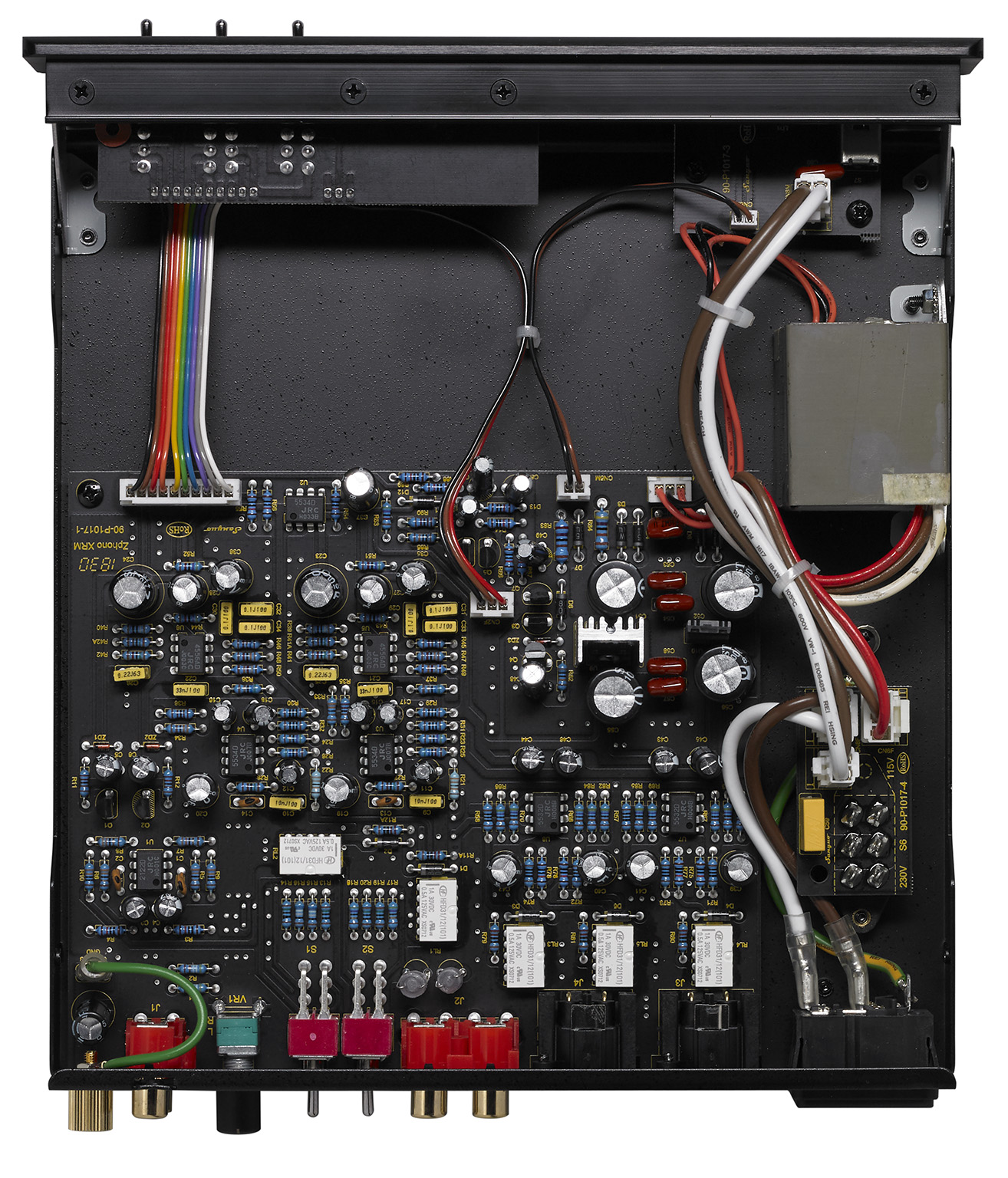
The arrival of the Parasound Zphono XRM allows me to write that we have been using it to listen to Heart To Mouth by LP on LP for the first time.
Although we have been a Laura Pergolizzi fan for some time now, we have previously listened to her only via CDs (they being somewhat less expensive), but we decided to bite the bullet with the arrival of Heart to Mouth, because we think it’s her best full album of work yet (though some individual songs on her earlier albums are stronger, the most obvious one being Lost on You from her album of the same name) and we thought the more introspective, meditative sound of Heart To Mouth would work better on LP than on CD.
Parasound’s Zphono XRM certainly wrought its magic throughout this album and the more we listened the more impressed we became. For a start, it’s quiet, so the lovely fade-in intro to Dreamcatcher, along with the crisp picking, was revealed perfectly.
Then, as the effects pile on as the track progresses, the artificial was kept in a separate acoustic space from the real. It also revealed the delicate sound of the ukulele on the intro to One Night in the Sun. Then, later on, those hand-claps sounded so real via the Zphono XRM.
Then there’s the way it handled the driving bass on Girls Go Wild, once again compartmentalising the various instruments while at the same time not separating them out from the mix, but integrating them into the whole. Nice. Very nice.
All the way through the album, the Zphono XRM stayed a constant at revealing the complex timbres of LP’s unique voice and kept up with the different vocal stylings she uses from cut to cut. (And why is it that so many singers with unusual voices seem to gravitate to the uke? (It’s a mystery.)
Next up we just had to hear how the Zphono XRM reproduced the sound of the sangari, a stringed instrument whose sound is famously difficult to reproduce, not least because it resembles the sound of the human singing voice.
If you’ve heard of it, you probably also know that the best-known exponent of it, at least in the Western world, is Suhail Yusuf Khan, who’s been in a trio with guitarist James Yorkston and double-bass player Jon Thorne for some years.
The album we played (Everything Sacred) is a few years old now, but we still think it’s one of their best. Listen to Knochentanz and you’ll hear first the sangari, but after some time (OK, after long time… it’s a long track) Khan himself starts singing and the effect, which is totally eerie, was delivered astoundingly well by the Parasound.
Possibly the weirdest track on this album – and maybe the weirdest song we’ve ever heard – is their cover of Little Black Buzzer (Ivor Cutler), but it’s a smorgasbord of sound, helped out by Lisa O’Neill and by what I can only imagine is Khan scatting in Indian. But the glory of the track was the insane clarity the Zphono XRM afforded this sonic smorgasbord. Amazing performances by all concerned.
But of all the songs on Everything Sacred, it’s probably Sufi Song that we like the best. Thorne’s continuo bass playing is like a warm reassurance that all is right with the world, while the interplay between Yorkston’s guitar and Khan’s vocals is aurally mesmerising.
But could the Parasound Zphono XRM handle total sonic mayhem? It didn’t take very long with Massive Attack’s classic Mezzanine to prove that it could. This is a difficult album to reproduce because of the sheer dynamics, not to mention incredible low-end that’s counterpointed by the percussion on the one hand and the ethereal voice of Elizabeth Fraser on the other.
Heartbeat-like bass lines mean you’re on edge for most of the album, with your senses primed to stun. Turn it up loud! And if MA is a bit too house for you, play what I followed up with… anything by Coldplay… or, preferably, everything by Coldplay.
And when you’re listening to the tracks recorded live in concert, listen especially to the accuracy with which the Zphono XRM delivers the sound of the audiences cheering, clapping and singing along.
Verdict
The Parasound Zphono XRM does everything you could possibly want a phono preamplifier to do – both sonically and electronically – magnificently well. Highly recommended.
Laboratory tests
The RIAA-corrected frequency response of the Parasound Zphono XRM, as measured by Newport Test Labs, is shown in Graph 1 below.
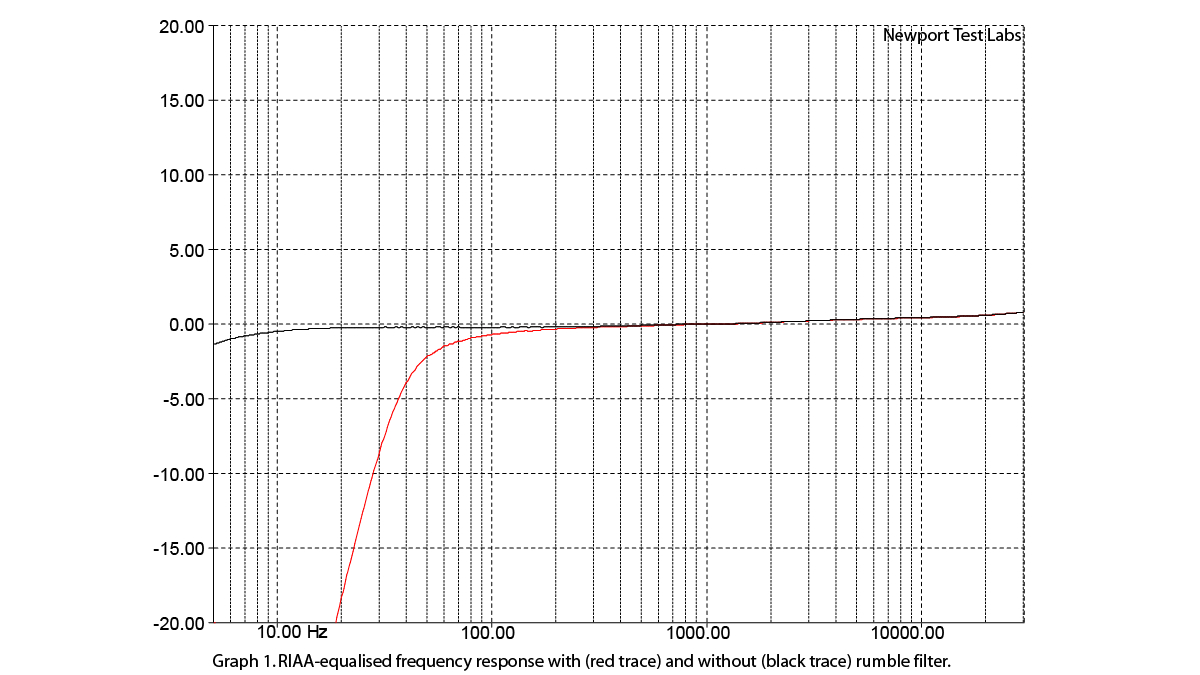
On this graph, the black trace is the response without the infrasonic filter and the red trace is the response with the infrasonic filter deployed.
You can see that the filter’s response starts deviating from that of the main response at around 400Hz, but there’s no disparity until 200Hz, after which it’s 5dB down at 38Hz, 10dB down at 28Hz and 20dB down at 18Hz.
Effectively, this means that it will effectively cut out rumble and other low frequency noises without having any significant effect on the music being played.
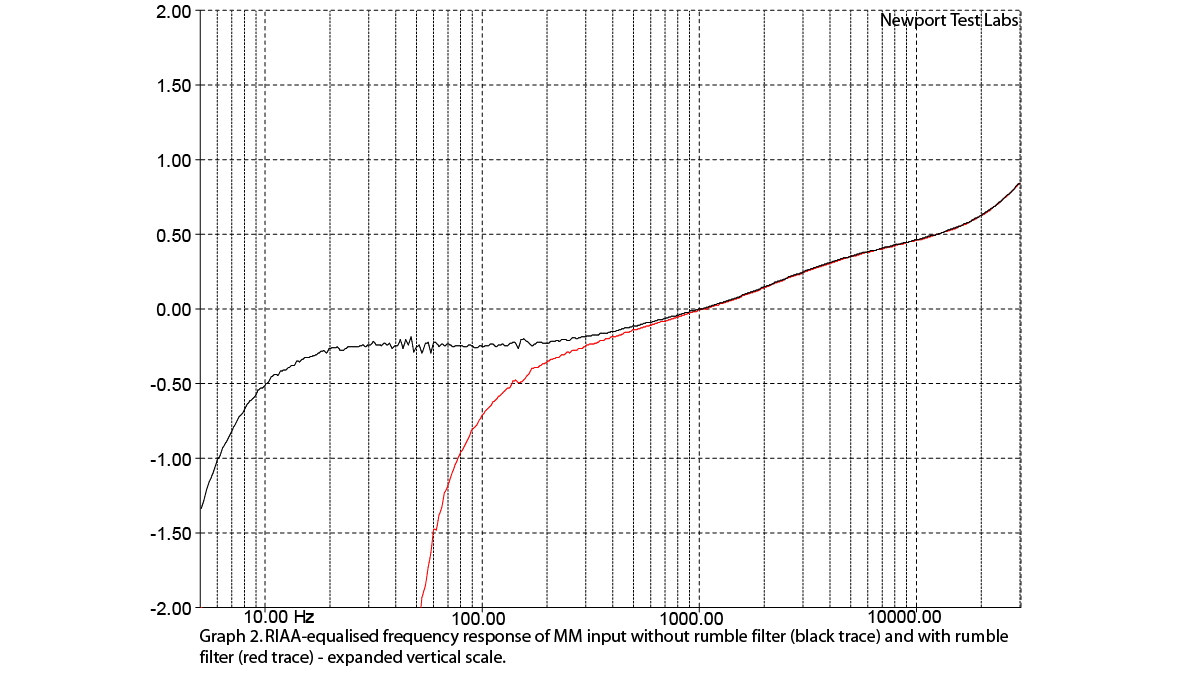
Graph 2 shows the same response as Graph 1, but with a magnified vertical graph scale, so you can see the frequency response of the Zphono XRM in more detail (though we lose the response of the filter because of the scale magnification).
The extra detail allows us to hang some dB variation figures on the response, and you can see that the Parasound Zphono XRM is 0.25dB down at 20Hz, 0.5dB down at 10Hz and 1.3Hz down at 5Hz. (The small glitches in the response at 50Hz and 150Hz are due to some mains hum creeping into the measurement and should be ignored.)
At high frequencies, you can see the response of the Zphono XRM rises to be +0.5dB at 13kHz, then +0.65dB at 20kHz and +0.75dB at 30kHz. This puts the audio band frequency response at 20Hz to 20kHz ±0.45dB, which is excellent.
Channel separation at 1kHz was measured by Newport Test Labs as being 85.4dB, which is an outstanding result for a phono preamplifier. At the same time, channel balance was an equally outstanding 0.013dB at this same frequency. Interchannel phase errors, as you can see from the tabulated results, were also low across the audio band.
Newport Test Labs measured the signal-to-noise ratios of the Zphono XRM using that input voltage which resulted in a 2V output on the highest gain settings for both MM and MC inputs and, as you can see, the Zphono delivered outstanding S/N results of 95dB A-weighted for its MM input and 81dB A-weighted for its MC input.
The result for the MM input bested Parasound’s own specification of 94dB, while Newport Test Labs’ measurement for the MC input was only a single dB below Parasound’s specification of 82dB. To re-state the obvious, both these are outstanding results for a phono preamplifier.
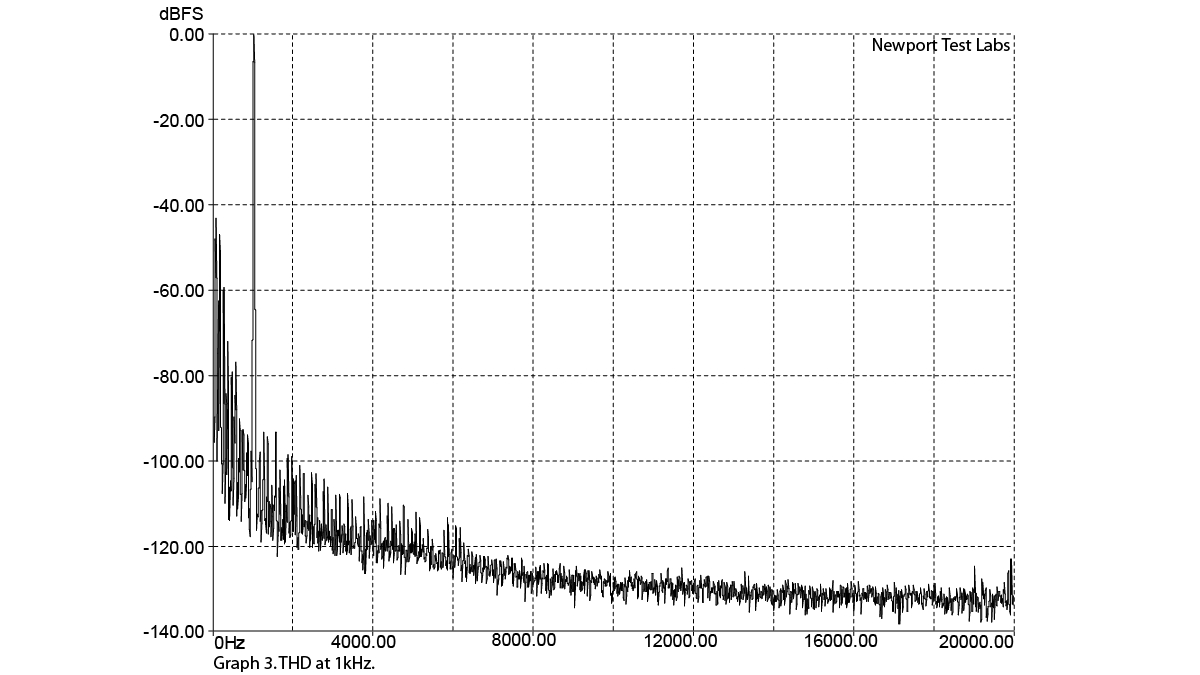
Distortion, as measured by Newport Test Labs, is shown in Graph 3 for a 1kHz test signal. You can see that if there is any second harmonic distortion, it’s buried down in the noise floor at -100dB (0.001% THD), and the same goes for any third harmonic component (-110dB/0.0003%) or fourth (-115dB/0.0001%). There is some noise at low frequencies, but it’s mostly more than 60dB down. A good result.
The Parasound Zphono XRM provides ample gain for both moving-magnet and moving-coil cartridges, as you can see for yourself from the tabulated results. A 10mV input at the MM input will result in a healthy 1-volt output using the 50dB gain setting and 3-volts using the 60dB setting.
These voltages (which we’ve rounded for use here in the text) were measured at the unbalanced outputs – the voltages at the balanced outputs were 2-volts and 6-volts respectively (again rounded). A 2mV input at the MC input, using the 60dB gain setting, results in 1.5V at the unbalanced output (3V at the balanced output). These results make the Parasound Zphono XRM completely compatible with any MM or MC cartridge we’ve ever heard of.
The actual gains through the Parasound Zphono XRM didn’t quite match up with the values stated on the switch settings, but were close enough as makes zero practical difference in operation, and the minuscule differences could be due to slight differences in loading during the measurements, or to production variances.
But for the record, Newport Test Labs measured the 40dB setting as delivering 40.19dB, the 50dB setting as delivering 49.72dB and the 60dB setting as delivering 57.5dB.
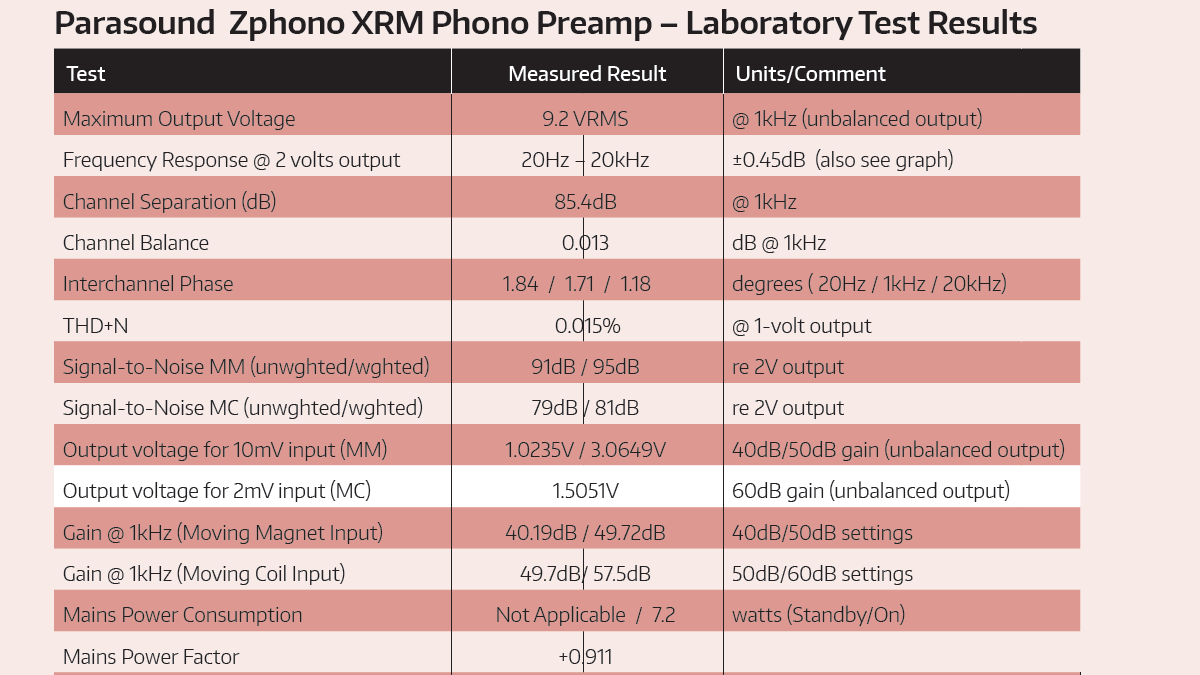
It is interesting that the Parasound Zphono XRM does not have a standby power feature, but on this device it would have added quite a bit of cost and increased circuit noise, plus made it difficult to meet the regulatory requirements of the different countries in which it would be sold, so I can understand why Parasound chose not to include one.
And because the Zphono XRM draws only 7.2-watts during operation, it’s not going to impact on your utility bill if you leave it on all the time, though we would still recommend you switch if off when you’re not using it. It runs quite warm when it is running, so it will come up to a stable operating temperature almost immediately after you switch it on.
Overall, the Parasound Zphono XRM performed outstandingly well on the test bench, returning a flat, extended frequency response, excellent channel separation, ultra-low distortion and vanishingly low noise.
Australian Hi-Fi is one of What Hi-Fi?’s sister titles from Down Under and Australia’s longest-running and most successful hi-fi magazines, having been in continuous publication since 1969. Now edited by What Hi-Fi?'s Becky Roberts, every issue is packed with authoritative reviews of hi-fi equipment ranging from portables to state-of-the-art audiophile systems (and everything in between), information on new product launches, and ‘how-to’ articles to help you get the best quality sound for your home.
Click here for more information about Australian Hi-Fi, including links to buy individual digital editions and details on how best to subscribe.
